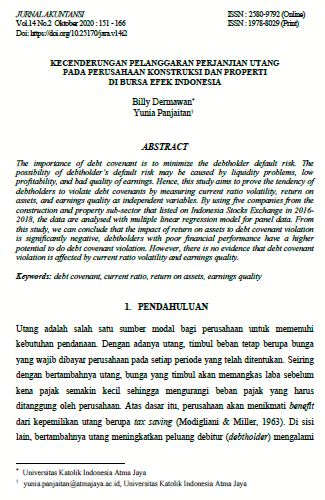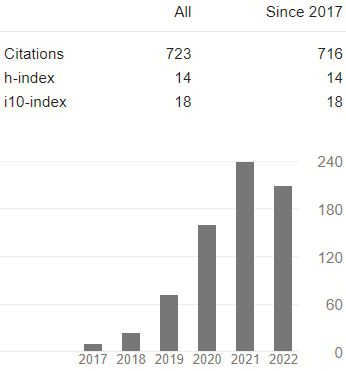KECENDERUNGAN PELANGGARAN PERJANJIAN UTANG PADA PERUSAHAAN KONSTRUKSI DAN PROPERTI DI BEI
DOI:
https://doi.org/10.25170/jak.v14i2.1232Keywords:
debt covenant, current ratio, return on assets, earnings qualityAbstract
The importance of debt covenant violation is to minimize the debtholder default risk. The possibility of debtholder’s default risk may be caused by liquidity problems, low profitability, and bad quality of earnings. Hence, this study aims to proof the tendency of debtholder to violate debt covenants by measuring current ratio volatility, return on assets, and earnings quality as independent variables. By using five companies from construction and property sub-sector that listed on Indonesia Stocks Exchange in 2016- 2018, the data are analyzed with multiple linear regression model for panel data. From this study, we can conclude that the impact of return on assets to debt covenant violation is significantly negative, debtholders with poor financial performance have higher potential to do debt covenant violation. However, there is no evidence that debt covenant violation is affected current ratio volatility and earnings quality.
References
An, Y. (2017). Measuring Earnings Quality Over Time. International Journal of Economics and Financial Issues, 7(3), 82-87.
Ashraf, S., Félix, E. S., & Serrasqueiro, Z. (2019). Do Traditional Financial Distress Prediction Models Predict the Early Warning Signs of Financial Distress?. Journal of Risk and Financial Management, 55(12), 1-17.
Ball, R., Shivakumar, L. (2006). The role of accruals in asymmetrically timely gain and loss recognition. Journal of Accounting Research 44(2), 207–242
Bradley, M., & Roberts, M. R. (2015). The Structure and Pricing of Corporate Debt Covenants. Quarterly Journal of Finance, 5(2), 1-37.
Brigham, E. F., & Houston, J. F. (2011). Fundamentals of Financial Management. Iowa, United States: Thomson Higher Education.
CNN Indonesia. (2018). A Time Warner Company. Retrieved from CNN Indonesia: https://www.cnnindonesia.com/ekonomi/20181018060036-92-339361/terlilit-utang-menahun-sariwangi-dinyatakan-pailit. Oktober 18.
CNN Indonesia. (2018). A Time Warner Company. Retrieved from CNN Indonesia: https://www.cnnindonesia.com/ekonomi/20181019143128-92-339804/matinya-sariwangi-dan-nyonya-meneer-tergerus-globalisasi. Oktober 20.
Daly, K. (2011). An Overview of The Determinants of Financial Volatility: An Explanation of Measuring Techniques. Modern Applied Science, 5(5).
Dechow, P.M., Schrand, C.M. (2004). Earnings Quality. The Research Foundation of CFA Institute.
DeFond, M., Jiambalvo, J. (1994). Debt covenant violation and manipulation of accruals. Journal of Accounting and Economics, 17, 145–176.
Demerjian, P. R. (2016). Uncertainty and Debt Covenants. Review of Journal Accounting Studies(22), 1156-1197.
Demerjian, P. R., & Owens, E. L. (2015). Measuring the Probability of Financial Covenant Violation in Private Debt Contracts. Journal of Accounting and Economics, 61(3), 433-447.
Dewatripont, M., & Tirole, J. (1994). A Theory of Debt and Equity: Diversity of Securities and Manager-Shareholder Congruence. Journal of Economics, 109(4), 1027-1054.
Dichev, I. D., & Skinner, D. J. (2002). Large-Sample Evidence on the Debt Covenant Hypothesis. Journal of Accounting Research, 40(4), 1091-1123.
Duke, J., Hunt, H. (1990). An empirical examination of debt covenant restrictions and accountingrelated debt proxies. Journal of Accounting and Economics, 12, 45–63.
Ghozali, I. (2001). Aplikasi Analisis Multivariate dengan Program SPSS. Semarang: Badan Penerbit Universitas Diponegoro.
Gu, Y., Mao, C. X., & Tian, X. (2017). Bank Interventions and Firm Innovation: Evidence from Debt Covenant Violations. Journal of Law and Economics, 637-671.
Gujarati, D. N., & Porter, D. C. (2009). Basic Econometrics (5th Ed.). New York: McGraw-Hill/Irwin
Jensen, M. C., & Meckling, W. H. (1976). Theory of the Firm: Managerial Behavior, Agency Cost and Ownership Structure. Journal of Financial Economics, 3(4), 305-360.
Karnadi, E. B. (2017). Panduan Eviews untuk Ekonometrika Dasar. Jakarta: PT Gramedia Widiasarana Indonesia.
Knight, F. H. (1921). Risk, Uncertainty and Profit. Quarterly Journal of Economics, 36(4), 682-690.
Lavinda, C. (2017). A Time Warner Company. Retrieved from CNN Indonesia:
https://www.cnnindonesia.com/ekonomi/20170904195610-92-239398/tagihan-utang-nyonya-meneer-capai-rp-252-miliar. September 4.
Li, F., Abeysekera, I. & Ma, S. (2011). Earnings Management and The Effect of Earnings Quality in Relation to Stress Level and Bankruptcy Level of Chinese Listed Firms. Corporate Ownership and Control, 9(1), 366-391.
Lubis, I. L., Sinaga, B. M., & Sasongko, H. (2017). Pengaruh Profitabilitas, Struktur Modal, dan Likuiditas Terhadap Nilai Perusahaan. Jurnal Aplikasi Bisnis dan Manajemen, 3(3), 458-465.
Mariano, B., & Tribo, J. A. (2014). Creditor Intervention, Investment, and Growth Opportunities. Journal of Financial Services Research, 47, 203-228.
Media Indonesia. (2018). Media Group. Retrieved from mediaindonesia.com: https://mediaindonesia.com/read/detail/169809-inflasi-sebabkan-daya-beli-masyarakat-memburuk. Juli 3.
Miller, M. H. (1977). Debt and Taxes. The Journal of Finance, 32(2), 261-275.
Modigliani, F., & Miller, M. H. (1963). Corporate Income Taxes and the Cost of Capital: A Correction. The American Economic Review, 53(3), 433-443.
Myers, S. C. (1977). Determinants of Corporate Borrowing. Journal of Financial Economics, 5, 147-175.
Myers, S. C. (1984). The Capital Structure Puzzle. The Journal of Finance, 39(3), 575-592.
Myers, S. C. (2001). Capital Structure. The Journal of Economic Perspectives, 15(2), 81-102.
Myers, S. C., & Majluf, N. S. (1984). Corporate Financing and Investment Decisions when Firms Have Information that Investors Do Not Have. Journal of Financial Economics, 13(2), 187-221.
Nini, G., Smith, D. C., & Sufi, A. (2009). Creditor Control Rights and Firm Investment Policy. Journal of Financial Economics, 92(3), 400-420.
Nurdin, N. (2017). Kompas Gramedia Digital Group. Retrieved from KOMPAS.com: https://ekonomi.kompas.com/read/2017/08/04/165429526/tak-mampu-bayar-utang-pabrik-jamu-nyonya-meneer-dinyatakan-pailit. Agustus 4.
Press, E., Weintrop, J. (1990). Accounting-based constraints in public and private debt agreements: Their association with leverage and impact on accounting choice. Journal of Accounting and Economics, 12, 65–95.
Ross, S. A., Westerfield, R. W., Jordan, B. D., Lim, J., & Tan, R. (2016). Fundamentals of Corporate Finance (2nd ed.). New York, United States: McGraw-Hill Education.
Scott, R. W. (1997). Financial Accounting Theory. New Jersey: Prentice-Hall.
Smith, C. W., & Warner, J. B. (1979). On Financial Contracting: An Analysis of Bond Covenants. Journal of Financial Economics, 7, 117-161.
Spence, M. (1973). Job Market Signaling. The Quarterly Journal of Economics, 87(3), 355-374.
Sugianto, D. (2018). detikfinance. Retrieved from detik.com: https://finance.detik.com/industri/d-4262474/kenapa-sariwangi-bisa-pailit. Oktober 18.
Watts, R., Zimmerman, J. (1986). Positive Accounting Theory. Prentice Hall, Englewood Cliffs, NJ.
Wruck, Karen Hopper. (1990). Financial Distress, Reorganization, and Organizational Efficiency. Journal of Financial Economics, 27, 19-44.

Downloads
Published
Issue
Section
License
Authors who publish with this journal agree to the following terms:
- Authors retain copyright and grant the journal right of first publication with the work simultaneously licensed under a Creative Commons Attribution-ShareAlike 4.0 International License that allows others to share the work with an acknowledgment of the work's authorship and initial publication in this journal.
- Authors are able to enter into separate, additional contractual arrangements for the non-exclusive distribution of the journal's published version of the work (e.g., post it to an institutional repository or publish it in a book), with an acknowledgment of its initial publication in this journal.
- Authors are permitted and encouraged to post their work online (e.g., in institutional repositories or on their website) prior to and during the submission process, as it can lead to productive exchanges, as well as earlier and greater citation of published work.














